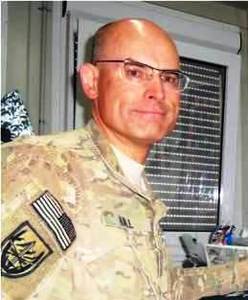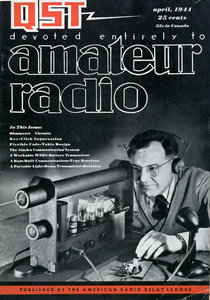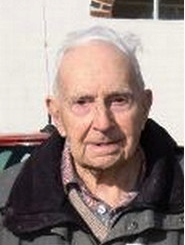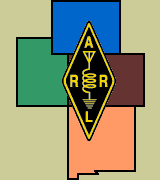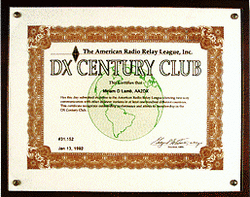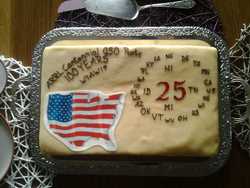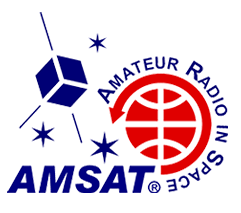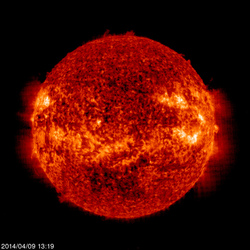 April 10, 2014 John E. Ross, KD8IDJ, Editor
| |||||||||||||||||||||||||||
Public Service: Amateur Radio-Developed Software Assisting in Search for Missing Airliner US Navy personnel helping to look for missing Malaysia Air Flight MH370 have used the signal-processing and analysis package Spectrum Laboratory by Wolf Buescher, DL4YHF, to analyze recently detected 37.5 kHz "pings" that may be from the missing plane's "black box." Some Spectrum Laboratory screen shots as seen aboard the Australian defense vessel Ocean Shield were shown on TV in Australia and in the UK. The US Navy personnel are guests aboard the Australian ship. VLF experimenter Warren Ziegler, K2ORS, said the software is the same package Amateur Radio experimenters used recently to detect transatlantic signals on 29 kHz.
"Wolf's package is first-rate software, and I know that there have been other professional uses, but this was quite an interesting one!" Ziegler said. The software began as a simple DOS-based FFT program, but it is now a specialized audio analyzer, filter, frequency converter, hum filter, data logger, and more. It's available for download from DL4YHF's Amateur Radio Software site. Buescher said he was skeptical about the initial "ping" detection by a Chinese search vessel, but later called the spectrogram taken by the US team aboard Ocean Shield "convincing." He said a screenshot from Australian TV clearly shows the "bip-bip-bip" ultrasonic bursts or pings, "just as they should look," he said, rather than a "just a wobbly carrier that comes and goes."
"In slow-CW terms, it would be an 'outstanding signal.'" Buescher said. "Now keeping fingers crossed that the ["black box"] batteries last a bit longer than specified. The experts say the pinger's battery usually degrades slowly, instead of going QRT abruptly." At mid-week, searchers had detected additional, more promising pings that appeared to conform to the pattern of those expected from an aircraft black box. Regulatory: FCC Makes the First Move in 5 GHz U-NII Devices Proceeding The FCC has taken the opening steps on its proposal (ET Docket 13-49) to make available another 195 MHz of spectrum at 5 GHz for Part 15 unlicensed National Information Infrastructure (U-NII) devices.
U-NII devices use "wideband digital modulation techniques to provide a wide array of high data rate mobile and fixed communications for individuals, businesses, and institutions," the FCC has explained. In a First Report and Order (R&O) in the proceeding released on April 1, the Commission affirmed that Amateur Radio is entitled to protection from interference by such unlicensed devices. "The Amateur Service is an allocated service entitled to interference protection within the 5 GHz spectrum," the FCC said, "whereas U-NII devices operate under our Part 15 rules." Amateur Radio has a secondary allocation at 5.65-5.925 GHz, including an Amateur Satellite Service uplink allocation of 5.65-5.67 GHz, and a downlink allocation of 5.83-5.85 GHz. In the R&O the FCC, among other things, extended the upper edge of the 5.725-5.825 GHz band to 5.85 GHz and consolidated the Part 15 rules "applicable to all digitally modulated devices operating across this 125 megahertz of spectrum to ensure that all such devices comply with U-NII requirements intended to protect authorized users from harmful interference," the FCC said. The Commission did not address the use of U-NII devices in the 5.35-5.47 GHz and 5.85-5.925 GHz bands, pending additional technical analyses of those bands. The FCC was obligated by the Middle Class Tax Relief and Job Creation Act of 2012 (PL 112-96) to begin a proceeding to amend its Part 15 rules to allow unlicensed U-NII devices to operate in the 5.35-5.47 GHz bands.
FCC Chairman Tom Wheeler called the R&O "a big win for consumers" that will offer much-needed relief from growing congestion on Wi-Fi networks. "At the same time," Wheeler continued, "it moves us another step closer to ending the analog-era debate of licensed vs unlicensed spectrum. In 2014, licensed and unlicensed spectrum are more complementary than competitive. They are less oil and vinegar, and more peanut butter and jelly." The FCC R&O turned away an ARRL suggestion that it require U-NII devices to employ dynamic frequency selection (DFS) and transmit power control (TPC) throughout the 5.650-5.925 GHz segment to minimize harmful interference to Amateur Radio operations in the shared spectrum. The Commission said such a requirement was unnecessary. In 1999, the Commission allocated 5.85-5.925 GHz for direct vehicle-to-vehicle and vehicle-to-roadside, or "Dedicated Short Range Communications" (DSRC). Amateurs may continue to operate in this segment, but only to the extent that they do not interfere with DSRC operations. In support of its argument that the introduction of U-NII into this segment would be premature, the ARRL has observed that "a U-NII overlay at the present time requires a good deal of compatibility analysis, none of which has been completed to date."
In its comments last May, the League traced a history of "a continuing series of overlays" to which the 5 GHz band has been subjected over the past 16 years, progressively reducing the utility of the amateur allocation there. And the League asserted that "a decision in the near term with respect to the addition of U-NII devices to the 5.85-5.925 GHz band would be premature," a conclusion the FCC now has reached. "Chairman Wheeler noted the need for careful study of technical analyses prior to expanding unlicensed access into the 5.85-5.925 GHz band," ARRL Chief Executive Officer David Sumner, K1ZZ, said. "We can only hope that he will insist on this study being done before the other shoe drops in this proceeding." Read more. Technology: WWV's 25 MHz Signal Back on the Air WWV silenced its 25 MHz signal in 1977, but it's back on the air "for old times' sake" -- on an "experimental basis." Resurrecting the long-dormant standard time outlet operated by the National Institute of Standards and Technology (NIST) was Matt Deutch, N0RGT, the lead electrical engineer at WWV.
It all came about after Dean Lewis, W9WGV, lamented the loss of the 25 MHz signal in an e-mail to Deutch, who surprised him by subsequently putting the signal back on the air on April 4 for about 3-1/2 hours. A listener in Scotland posted a reception report of the WWV 25 MHz signal on YouTube. WWV ran another 25 MHz test starting on April 7. Initially it was only to stay up for 24 hours or so, but Deutch told ARRL that WWV will remain on the air probably for the rest of the week. "So hopefully a few more people will hear it," he said. Lewis said he'd told Deutch last week that 10 meter propagation has been very good at this point in Cycle 24, and he uses the various WWV frequencies as propagation beacons every day. "He responded that 'for old times' sake,' they'd put the signal back on the air for a while. I assumed, of course, that he was kidding, and so I didn't check. Matt wasn't kidding!" NIST said the 25 MHz broadcast consists of the normal WWV signal heard on all other WWV frequencies, at the same level of accuracy. The transmitter in Fort Collins, Colorado, can deliver 2500 W into its "broadband monopole" antenna, although Deutch told ARRL that he is running it at 1200 W. WWV has invited listeners' comments and signal reports. Legislative: Washington Aeronautic Safety Law Exempts Amateur Radio "Guyed Towers" Washington Governor Jay Inslee has signed into law legislation aimed at providing a "safer flying environment" for pilots of aircraft engaged in "low-flying activities," such as crop dusting and search-and-rescue activity. The new law includes provisions to alert pilots to "guyed towers that may be erected at short notice" that might be hard to see and pose an air safety hazard, and it contains specific marking and lighting requirements. Specifically exempted from the new law is, "Any structure for which the primary purpose is to support telecommunications equipment, such as equipment for Amateur Radio and broadcast radio and television services regulated by the Federal Communications Commission."
ARRL Field Organization volunteers in Washington worked with lawmakers to have the exemption included. Also exempted are self-supporting utility poles and towers, and guyed towers that are used for military purposes, are within 50 feet of a structure or vegetation of equal or greater height, or are attached to a "large mobile motorized machine" such as one used to yard timber. Impetus for the legislation -- similar to legislation being considered or enacted in other Western states -- was a 2013 National Transportation Safety Board recommendation that called upon states and territories to enact legislation "requiring that meteorological evaluation towers erected in your state or territory are marked and registered in a directory." The recommendation came in the wake of fatal aircraft accidents involving collisions with meteorological evaluation towers (METs), which often are erected on short notice and lack markings or lighting to make them more visible to pilots. Your League: ARRL Releases First Repeater Directory App for Android Devices
ARRL has introduced its first Android app for locating Amateur Radio repeater frequencies in the US and Canada -- The ARRL Repeater Directory®...Powered by Travel Plusâ¢. Android phone and mobile device users can download the app at no cost from Google Play⢠(an Apple iOS version is coming soon). The free app provides limited access to The ARRL Repeater Directory database. Users may purchase a subscription to the complete database of 23,000 repeaters, but the full version of the app is included in the price of The ARRL Repeater Directory print editions. "You're probably more likely to have your smartphone at your fingertips when searching for a repeater while traveling," ARRL Marketing Manager Bob Inderbitzen, NQ1R, pointed out. "The app can quickly locate you and deliver a list of nearby repeaters to tune in." Inderbitzen says users can browse the entire database by city and state too, even while offline. The app's database contains the current list of frequencies included with the 2014-2015 hard copy editions of The ARRL Repeater Directory and in the TravelPlus for Repeaters software. "ARRL assembles this data each year from frequency coordinators recognized by the National Frequency Coordinator's Council and carefully vetted submissions from individual repeater owners," said ARRL Publication Manger Steve Ford, WB8IMY, who edits the directory. The database includes repeaters from 28 MHz to 1240 MHz, and includes ATV, D-Star, APCO-25, Digital Mobile Radio (DMR), EchoLink, and IRLP machines.
The ARRL Repeater Directory app can search for frequencies by city and state, or by current location, if you've enabled location services on your device. Selecting a listing reveals detailed information on the repeater and its features. Users can filter searches to see only repeaters that match certain attributes, and mapping is integrated. Users may purchase an activation code from ARRL for 12 months of access to the full version for $9.95. The hard copy 2014-2015 Repeater Directory, also available from ARRL or from an ARRL publications dealer, includes an activation code for access to the full version of The ARRL Repeater Directory app. The pocket-sized edition is $12.95, and the desktop edition is $17.95 -- both including the app (plus shipping). The activation code permits single users to activate the full version of the app for 12 months on up to three devices. ARRL produced the app with DHF Systems, the developer of ARRL's Travel Plus for Repeaters⢠software. ARRL Centennial: W1AW Centennial Operations Now in Massachusetts, Virginia, and Puerto Rico The ARRL Centennial "W1AW WAS" operations taking place during 2014 from each of the 50 states are now in Massachusetts (W1AW/1), Virginia (W1AW/4), and Puerto Rico (W1AW/KP4). They will relocate at 0000 UTC on Wednesday, April 16 (the evening of April 15 in US time zones), to Mississippi (W1AW/5) and North Dakota (W1AW/0). During 2014 W1AW will be on the air from every state (at least twice) and from most US territories, and it will be easy to work all states solely by contacting W1AW portable operations.
In conjunction with the 100th anniversary of the ARRL, the ARRL Centennial QSO Party kicked off January 1 for a year-long operating event in which participants can accumulate points and win awards. The event is open to all, although only ARRL members and appointees, elected officials, HQ staff, and W1AW are worth ARRL Centennial QSO Party points. Working W1AW/x from each state is worth 5 points per contact. To earn the "Worked all States with W1AW Award," work W1AW operating portable from all 50 states. (Working W1AW or W100AW in Connecticut does not count for Connecticut, however. For award credit, participants must work W1AW/1 in Connecticut.) A W1AW WAS certificate and plaque will be available. The ARRL has posted an ARRL Centennial QSO Party leader board that participants can use to determine how many points they have accumulated in the Centennial QSO Party and in the W1AW WAS operations. Log in using your Logbook of The World (LoTW) user name and password, and your position will appear at the top of the leader boards. Results are updated daily, based on contacts entered into LoTW. As of April 7, W1AW/x Centennial QSO Party stations have logged nearly 740,000 contacts. In May, W1AW will begin to revisit states already activated, starting with Utah, Nebraska, and New York. ARRL Centennial Station Giveaway! The ARRL has announced a "Centennial Station Giveaway" as part of its National Centennial Convention in Hartford, Connecticut, July 17-19, 2014. Sponsored by the ARRL and R&L Electronics, the first-prize winner will receive a Grand Prize voucher worth up to $5000 of equipment -- radio, antenna, and accessories -- redeemable for products sold by R&L Electronics. A second-prize winner will receive a $2500 prize voucher for products sold by FlexRadio Systems, also co-sponsored by ARRL.
All paid convention registrants will be entered in the prize drawings (door prizes). Winners will be drawn from among eligible registrants at the end of the convention on Saturday, July 19, 2014. The winner does not need to be present during the drawings. Three-day convention tickets are $75 and include an all-day training workshop and lunch on Thursday. Two-day tickets are $25 ($30 at the door), good for admission on Friday and Saturday. Everyone who attends the convention must register. DX: Mellish Reef DXpedition Yields to Weather After keeping the DX world on tenterhooks for a day or two, the VK9MT DXpedition to Mellish Reef finally called it quits when severe weather conditions made it "unsafe to continue operating." The team made its last contact -- with JL1MTY on 30 meters on April 4 at 1353 UTC -- and pulled the big switch. The DXpedition had planned to operate until April 9. "Due to the ever-worsening weather associated with an impending tropical storm, the team decided in the interest of safety to end the operation early," the dreaded announcement came on April 5 in US time zones. "The last night on the island was extremely difficult. With continued heavy rain and wind, radio operations were nearly impossible. While the team is disappointed, we realize that you are even more disappointed."
Once clear of the island, the team set sail for Australia, seeking a course to keep them ahead of the storm that prompted their premature departure. Team Mellish said that before shutting down, it was able to give an elderly South African radio amateur his last one for top of the DXCC Honor Roll. VK9MT also was an all-time new one for many others. Things started turning bad late last week, when the DXpedition was hit by torrential rain and high winds. Although the operating tents held up and no equipment was damaged, the team began dismantling some antennas and removing non-essential gear from the atoll, while still keeping at least three stations on the air. The DXpedition team arrived safely in Mackay, Australia, a few days after departing Mellish Reef. VK9MT recorded slightly more than 40,000 contacts during its stay from March 30 to April 4 -- the lion's share with Europe and Asia. Logs and statistics are available via ClubLog. -- Thanks to Team Mellish and Tim Beaumont, M0URX International: UK Amateurs Losing Access to Part of 2.3 GHz and 3.4 GHz Bands UK telecommunications regulator Ofcom has announced that it's ending Amateur Radio access to significant portions of the 2.3 and 3.4 GHz bands. The action, announced on April 7, came in the wake of a year-long "consultation" -- a rule-making proceeding -- that involved the release by the Ministry of Defence of 40 MHz of spectrum at 2.3 GHz and 150 MHz of spectrum at 3.4 GHz. Amateur Radio is secondary on the bands. Amateur Radio will lose privileges on frequencies in the two bands that overlap with spectrum that Ofcom plans to award for "new civil uses" -- 2350 to 2390 MHz and 3410 to 3475 MHz. The announcement gives radio amateurs at least 12 months' notice, but radio amateurs must comply immediately with procedures to avoid interfering with other users; ham radio occupants of 2310 to 2350 MHz will have to register their use and provide details to Ofcom.
Amateur Radio will retain access to the adjacent bands, but Ofcom has put procedures in place to remove even those frequencies from Amateur Radio access, if necessary in the future. Ofcom said earlier this year that with military and other government use of the 2.3 and 3.4 GHz spectrum ending, "we believe an award of the spectrum for high power use is likely to deliver greater benefit to UK consumers and citizens than continued amateur use." Ofcom was required by the Ministry of Defence to adequately protect its systems from Amateur Radio interference in both the released spectrum and in adjacent bands. "The MoD's plans are part of a government commitment to release 500 MHz of spectrum by 2020," Ofcom explained in its order. "This commitment to opening up spectrum for new civil uses is based on growing demand from UK consumers for spectrum-hungry devices such as smartphones and tablets." Ofcom said that use of mobile data devices more than doubled in the 18 months leading up to January 2012. "Indeed, the 2.3 and 3.4 GHz bands are identified in Ofcom's 'mobile data strategy' as having the potential to support even better mobile data services for citizens and consumers in the coming years," the regulator said. Ofcom said it was making 2300-2302 MHz available for amateur use, but licensees first must obtain a Notice of Variation to their licenses. Hams in the US have secondary access to 2300-2310 MHz, 2390-2450 MHz, and 3300-3500 MHz. Neither the affected 2350-2390 MHz segment nor the 2310-2350 MHz that may be removed down the road in the UK has been available to US amateurs for many years. In the international Table of Frequency Allocations, the 3.4-3.6 GHz band is designated for future mobile wireless broadband in many countries, including the UK, but not in the US. Germany and Israel are the only ITU Region 1 countries with amateur allocations at 3400-3475 MHz. -- Thanks to RSGB, Ofcom On the Air: The ARRL Rookie Roundup SSB is Sunday, April 20! The Rookie Roundup returns to SSB on Sunday, April 20. The event gets underway at 1800 UTC and continues through 2359 UTC. In the Rookie Roundup, a "Rookie" is any radio amateur licensed within the current calendar year or in the previous two calendar years, regardless of license class. Operators exchange the call sign of the station they're working plus their own call sign, first name, two-digit number of the year first licensed, and state, Canadian province, Mexican call area, or "DX."
The goal of Rookie Roundup is to encourage newly licensed operators in North America (including territories and possessions) to operate on the HF bands and experience competitive Amateur Radio operating. Experienced operators are encouraged to participate and help new operators -- either on the air or in person. This is a terrific opportunity for new operators to get on the air and gain contesting skills. Old Timers may want to consider opening up their stations to rookies and serving as contesting mentors. The more operators on the air, the more fun the Roundup will be for everyone. Review the rules before the event, and get familiar with logging and log submission processes too. Rookies exchange information with as many other stations as possible on the 80, 40, 20, 15, and 10 meters. Rookie entrants are encouraged to read "HF Contesting - Good Practices, Interpretations and Suggestions." The next Rookie Roundup is the RTTY event on August 17. On the Air: HI-SEAS Project Inaugural Ham Radio Event Will Commemorate Yuri Gagarin's Space Flight
The Hawaii Space Exploration Analog and Simulation -- HI-SEAS "Mars mission," recently underway in Hawaii, will launch its Amateur Radio special event on April 12 -- the anniversary of Soviet Cosmonaut Yuri Gagarin's historic spaceflight in 1961. Ron Williams, N9UIK, one of two radio amateurs on the mission -- the other is Ross Lockwood, VA6RLW -- said this week that the team's first Amateur Radio activity will begin Saturday, April 12, at 1900 UTC. Special event station K6B will explain the nature and purpose of the event and solicit callers. Amateur Radio communication to and from the "Martian" enclave will incorporate a 20 minute delay in each direction, to emulate actual transmissions between the Red Planet and Earth.
USSR Cosmonaut Gagarin was the first human launched into space during the US-Soviet "Cold War" space race. "The HI-SEAS crew will be celebrating in our habitat and will recognize this human achievement on its anniversary, during our first ham radio activity," Williams said. The HI-SEAS "astronauts" will be spending the next 4 months in a self-contained, solar-powered habitat at a remote site some 8000 feet up on the slopes of Mauna Loa volcano. Special event station K6B will call on the WH6FM 2 meter repeater, which is connected to the AllStar VoIP system (node 27084) as well as to the Western Intertie Network (WIN) linked repeaters (reflector 9101). K6B also will transmit into local 2 meter and 70 centimeter repeaters. At 2000 UTC, K6B will begin operation on 28.300 MHz. Williams said that imposing the delay makes the K6B operation "unique to any Amateur Radio special event ever conducted." He said that NASA is "very interested" in learning how to deal with radio signal delay to and from space. Read more. People: AMSAT-NA Names New Vice President of Engineering The AMSAT-NA Board of Directors has tapped Jerry Buxton, N0JY, to be AMSAT's Vice President of Engineering. In a special AMSAT meeting held online on April 1, the board unanimously approved the selection of Buxton, who lives in Granbury, Texas. He replaces Tony Monteiro, AA2TX, who died on March 26.
"Given the significance of completing Fox-1 for delivery on time later this year, the Board recognized that the Fox Program must continue under leadership that is focused on completing AMSAT's latest satellite," AMSAT announced. "Selecting a new VP-Engineering is an important step towards maintaining the momentum that was developed under Tony's leadership and to avoid creating an engineering leadership vacuum as work continues on the satellite." Steve Coy, K8UD, will assume Monteiro's seat on the AMSAT-NA Board of Directors. Coy was elected by the AMSAT membership as a Board alternate in 2013; he will hold a voting seat through the next Board election later this year. Read more. -- Thanks to AMSAT News Service Awards: Eric Hall, K9GY/T6MO, Named Intrepid Spirit Award Winner The Intrepid-DX Group has announced that DXer and DXpeditioner Eric Hall, K9GY/T6MO, is the recipient of its second annual Intrepid Spirit Award.
"This award is to recognize Eric's outstanding efforts to activate Afghanistan during his tour of duty as a US Army reservist, making over 41,000 contacts," the group's award announcement said. "We acknowledge Eric's pursuit of operating excellence and his quest to activate the rare and often dangerous entities." Hall will receive the award at the DX Dinner on May 16, held in conjunction with Dayton Hamvention®. This Intrepid-Spirit Award was made in memory of James McLaughlin, T6AF, who died in Afghanistan 3 years ago. -- Thanks to Paul Ewing, N6PSE, President, The Intrepid-DX Group Awards: Nominations Open for Amateur Radio Newsline Young Ham of the Year Nominations are being accepted for the 2014 Amateur Radio Newsline "Young Ham of the Year Award" (YHOTY) Created in 1986, the award recognizes the achievements of a radio amateur aged 19 or younger for his or her accomplishments in service to the nation, the community, or the advancement of the state of the art through Amateur Radio.
Nominees must reside in the US or its possessions, or in Canada. Details, rules, and a nominating form (in MS Word format) are available on the ARNewsline website. All nominating forms and support documentation become the property of Amateur Radio Newsline and cannot be returned. Nominations must be postmarked or electronically filed by May 30, 2014. -- Thanks to ARNewsline Feature: A Century of Amateur Radio and the ARRL During the war years, QST featured a number of articles on basic cryptanalysis, an important wartime area. Other articles went back to radio basics, to help hams still at home to brush up on their theory. Still others reported on advances in the state of the radio art. Articles showed military radio setups in use by the Signal Corps in the field during training exercises, by the Army Air Corps, by the Navy on board ships, by the Marines, and by the Coast Guard. The ARRL stood firmly behind the war effort, and did everything it could to help it. QST began listing the names of hams who were missing in action, and of those confirmed by the Red Cross as being prisoners of war. Later in the war, QST carried reports of "Gold Star" hams -- those who had died as a result of military action.
The principles of radar were well known in the technical community, but this was highly classified work during the war. The veil of military secrecy was lifted just enough for the first "official" announcement of the existence of radar in the military to be made on April 25, 1943. Later in the war, US hams started receiving unusual German-language signals in the vicinity of 10 meters. An investigation by the FCC and other government agencies showed that what those hams were hearing were transmissions from tank-borne tactical radios of the Afrika Korps, commanded by Field Marshall Erwin Rommel -- "the Desert Fox" -- during battles in North Africa. Hams who were fluent in German had a ringside seat to some fierce action! By 1944, stories of hams' experiences in military action began appearing in QST. The magazine also included such tales as "Hamfest in North Africa" (QST, Feb 1944), as hams got together here and there around the world. In Brief...
French Radio Amateur Still Active at 100 Years: Ivan Pastre, F3AT, of Saint Georges sur Baulche, France, turned 100 years old on April 7. A ham since 1931, when he was licensed as F3AU, he remains very active on the air after 83 years, still chasing new band countries for the DXCC Challenge. F3AT is at the top of the DXCC Honor Roll. He's a member of FOC, CDXC(F) and other organizations. Pastre has also operated as FQ3AT (1947), FQ3AT/FE (1947), FE8AB (1948), and FF8AG (1951). Joyeux anniversaire, Ivan! -- Thanks to Maurice Charpentier, F5NQL; QRZ.com
2014 ARRL Rocky Mountain Division Convention Changes Venue Due to extenuating circumstances, the 2014 ARRL Rocky Mountain Division Convention, originally scheduled to be held July 11-13 in Laramie, Wyoming, will take place instead August 8-10 in Albuquerque, New Mexico, in conjunction with the Duke City Hamfest. The Laramie event has been cancelled. Led by the organizers of the 2011 Division Convention in Taos, the annual Duke City Hamfest is a standing three-day Amateur Radio convention held in one of Albuquerque's largest hotels. Details about the 2014 ARRL Rocky Mountain Division Convention in Albuquerque will soon be available. -- Thanks to ARRL Rocky Mountain Director Brian Mileshosky, N5ZGT
Crimea is Not a New DXCC Entity: The ARRL Awards Committee has evaluated the current situation in Crimea in light of the DXCC rules and has determined that Crimea is not a DXCC entity. Neither Russia nor Ukraine is a rare entity and the vast majority of confirmations used for DXCC credit for either entity do not involve Crimea. DXCC Rule 4 reads: "Confirmation data for two-way communications must include the call signs of both stations, the entity name as shown in the DXCC List, mode, date, time and band. Except as permitted in Rule 1, cross-mode contacts are not permitted for DXCC credits. Confirmations not containing all required information may be rejected." Bottom line: A QSL with a call sign issued by the administration of Ukraine and showing the entity name as Ukraine counts as Ukraine. A QSL with a call sign issued by the administration of Russia and showing the entity name as Russia counts as Russia. A QSL that satisfies neither condition does not count for either entity. -- Thanks to Bill Moore, NC1L, DXCC Administrator
German Team is Halfway to W1AW Centennial WAS: The German team of DH4JQ, DL1EK, and DF9JS is halfway toward its goal of working W1AW in all states, as it moves from state to state during the ARRL Centennial QSO Party. The Deutscher Amateur Radio Club-affiliated trio has worked the first 25 of the states active as W1AW portable operations this year, and they celebrated with a commemorative cake. When the team works all 50 states, it's planning "a big barbecue." -- Thanks to Peter Bruins, DH4JQ
ARTSAT1:INVADER Satellite Gets OSCAR Number: The ARTSAT1:INVADER satellite (call sign JQ1ZKK) has been designated CubeSat OSCAR-77 or CO-77, according to Bill Tynan, W3XO, AMSAT-NA OSCAR Number Administrator. INVADER, a 1U CubeSat launched February 27, is an "Art Satellite" developed by students at Japan's Tama Art University as a part of the "ARTSAT: Art and Satellite Project," which aims at practical uses of a satellite for art and design. It carries a CW beacon on 437.325 MHz, a 1200 bps FM AX.25 Packet Radio and FM Digitalker on 437.200 MHz and a low-resolution camera. -- Thanks to AMSAT, ARTSAT Project The K7RA Solar Update Average daily solar flux weakened over the past week, and so did the outlook for the near term. Average daily solar flux declined from 149 to 142.2, while average daily sunspot numbers remained about the same, moving from 130.4 to 129.3 According to the NOAA/USAF 45 day forecast, predicted solar flux is 130 for April 10-11, 135 for April 12-16, 140 for April 17-19, 135 for April 20-23, 130 for April 24-27, 125 for April 28-May 3, and 140 for May 4-6.
That April 9 prediction shows an average daily solar flux of 133.3 over the next 6 days, April 10-15. But just 2 days earlier, on April 7, the predicted average for the same period was 142.5. On March 30 the prediction for April 10-15 showed an average solar flux of 145.8. The predicted solar flux for April 10 was 150 on March 30, 140 on April 7 and 130 on April 9, indicating a progressively pessimistic outlook. Predicted planetary A index is 7 on April 10, then 5, 8, 10 and 8 for April 11-14, 5 for April 15-16, 8 for April 17-19, and 5 on April 20 and through the end of the month. This weekly "Solar Update" in The ARRL Letter is a preview of the "Propagation Bulletin" issued each Friday. The latest bulletin and an archive of past propagation bulletins is on the ARRL website. In tomorrow's bulletin look for an updated forecast and reports from readers. Send me your reports and observations. Just Ahead in Radiosport
Visit the Contest Calendar for details. Upcoming ARRL Section, State and Division Conventions and Events
Find conventions and hamfests in your area.
ARRL -- Your One-Stop Resource for Amateur Radio News and Information Join or Renew Today! ARRL membership includes QST, Amateur Radio's most popular and informative journal, delivered to your mailbox each month. Listen to ARRL Audio News, available every Friday. Subscribe to... NCJ -- National Contest Journal. Published bi-monthly, features articles by top contesters, letters, hints, statistics, scores, NA Sprint and QSO Parties. QEX -- A Forum for Communications Experimenters. Published bi-monthly, features technical articles, construction projects, columns and other items of interest to radio amateurs and communications professionals. Free of charge to ARRL members: Subscribe to the ARES E-Letter (monthly public service and emergency communications news), the ARRL Contest Update (bi-weekly contest newsletter), Division and Section news alerts -- and much more! Find us on Facebook. Follow us on Twitter.
| |||||||||||||||||||||||||||
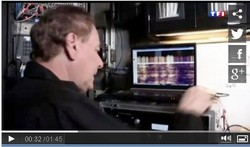
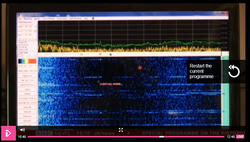
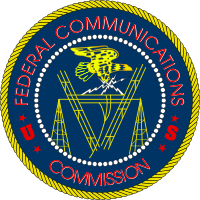
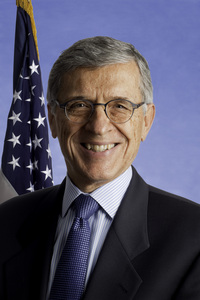
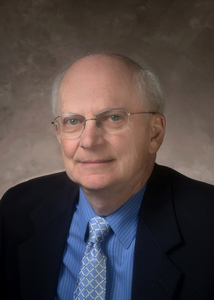
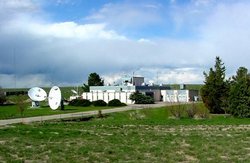
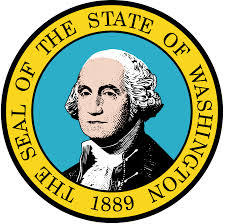
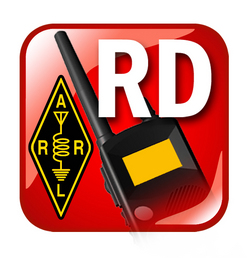

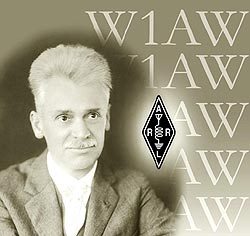
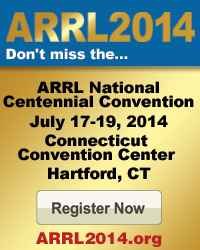
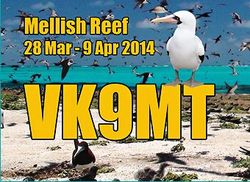
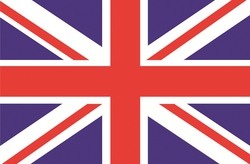
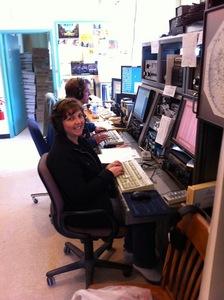


.jpg)
